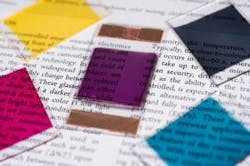Georgia Tech group fashions electrochromic materials of many colors
A group of researchers in the laboratory of John Reynolds, a professor in the School of Chemistry and Biochemisty and the School of Materials Science and Engineering at the Georgia Institute of Technology (Georgia Tech; Atlanta, GA), have created a broad color palette of electrochromic polymers, including cyan, yellow, magenta, and other colors even including four shades of the difficult-to-generate brown.1 The research is supported by chemicals producer BASF (Mannheim, Germany).
Potential uses of the electrochromic material include sunglasses, windows, signage, and even greeting cards that change color through the application of low-voltage electrical current.
To demonstrate their capabilities, the researchers created brown lenses for sunglasses using a five-layer sandwich of materials, including a film of the electrochromic material, a charge storage layer, and a UV-curable electrolyte, with a cathode and anode layer on either side.
The lenses can be switched between a colored and colorless state by applying a brief pulse of electrical current and do not need a continuous power supply. To maintain the colorless state, a brief refresh pulse needs to be applied approximately every 30 minutes; however, the colored state can be stable for up to several days. The materials can switch from about 10% transmittance to 70% transmittance and back in a few seconds.
Voltage-driven redox reaction
The electrochromic materials rely on a reduction-oxidation (redox) reaction triggered by the application of an electrical potential provided by a simple coin battery: +1 V causes the glasses to be clear, while -1 V switches to the color. "Essentially, we are just charging and discharging the device, which is what causes the color change," says Eric Shen, a postdoctoral fellow at Georgia Tech.
The researchers have used simple spray and blade-coating techniques to create films of the materials. They now are using ink-jet printing to create patterns and mix the polymers to create colors.
"We have shown that we can switch them on and off thousands of times, and that we can shine strong light on them without causing degradation of the color," says Shen.
REFERENCE:
1. Anna M. Österholm et al., ACS Applied Materials & Interfaces (2015); http://www.dx.doi.org/10.1021/am507063d
About the Author
John Wallace
Senior Technical Editor (1998-2022)
John Wallace was with Laser Focus World for nearly 25 years, retiring in late June 2022. He obtained a bachelor's degree in mechanical engineering and physics at Rutgers University and a master's in optical engineering at the University of Rochester. Before becoming an editor, John worked as an engineer at RCA, Exxon, Eastman Kodak, and GCA Corporation.

